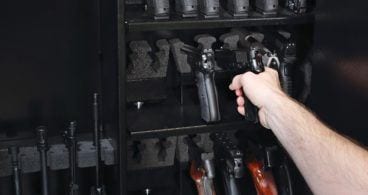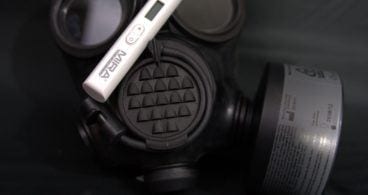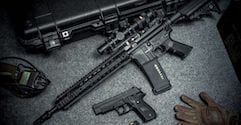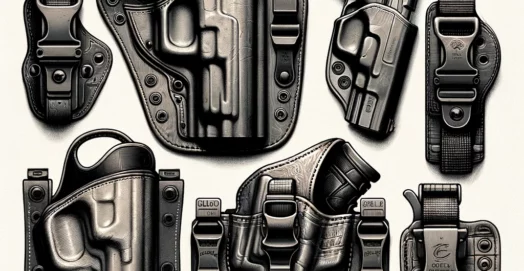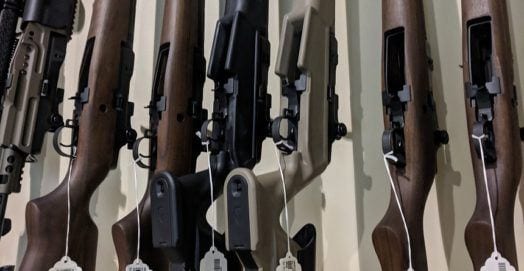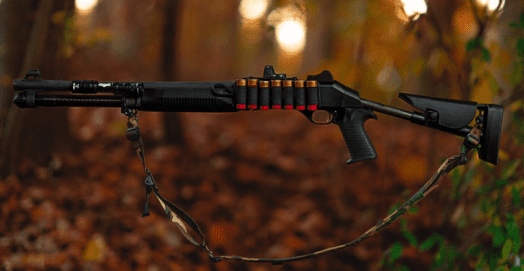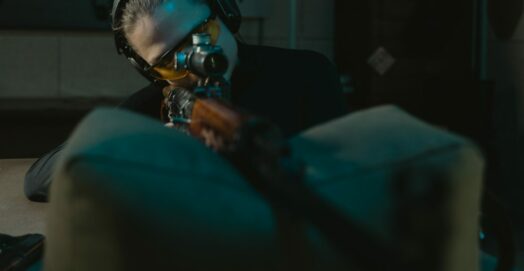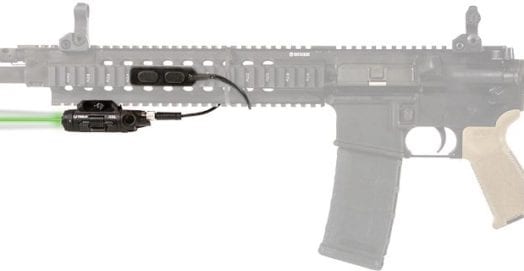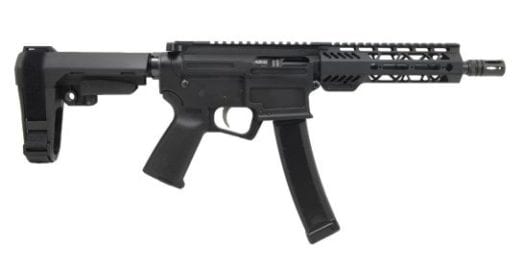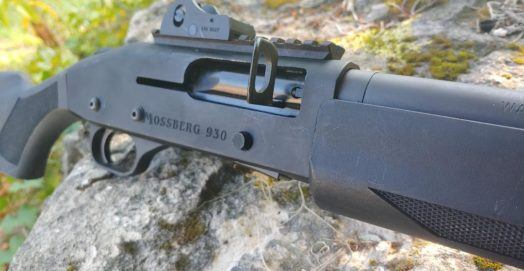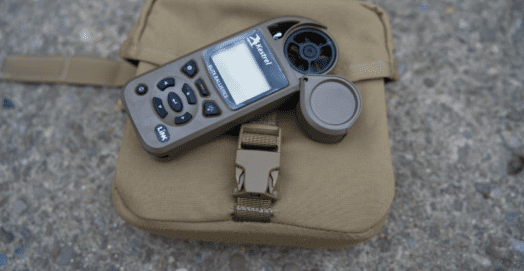Best Gun Safes: Keeping Your Firearms Secure

As a gun owner, there are plenty of reasons why you should consider investing in a good-quality gun safe. Let’s look at a few of them, so you can make an educated decision on what gun safe might be the best choice for your needs.
Kids in the household: If you have kids in your home, it’s essential that you prevent children who are too young to understand the concept of gun safety from getting hold of your firearms.
Neighborhood kids: Even if your own children are well-educated and responsible around guns, there’s always the chance that their friends may not be quite so savvy.
Firearms are Expensive: High-quality firearms are also valuable so you’ll want to keep them protected from damage in the event of a house fire, and a robust gun safe will do this for you.
Guns are targets for thieves: Finally, the black market in stolen guns is always buoyant, and this can make collections of sought-after firearms a target for burglars. A strong, well-made gun safe will help to keep your investment protected from would-be thieves.
A top-quality gun safe is not a cheap purchase so you want to buy one that will last you a lifetime. There are plenty of options to look at and knowing which to go for can be confusing. To help you make a well-informed choice, we’ve chosen our three favorites if you want to skip the rest of this monster guide. Otherwise, read on through our buyer’s guide, as well as our in-depth review of each safe.
Buyer’s Guide
There are two primary options to consider when you’re looking at gun safes. Long gun safes and smaller handgun safes, which includes biometric gun safes that have fingerprint recognition.
Although buying a gun safe to suit the nature of your gun collection may sound pretty self-explanatory, there are a few other vital matters that you need to consider.
Let’s look at the 10 different elements you should consider before making your gun safe selection.
1. Safe Capacity

Some gun safe manufacturers advertise their products with a greater capacity than is actually practical. Unfortunately, canny interior design usually results in the inclusion of racks and other features that hold rifles far too close together. Interiors designed in this way probably won’t suit guns that have wide fore-ends, pistol grips, long barrels and mag wells.
So, when making your choice, bear in mind that a gun safe that is advertised as having a 10 gun capacity will probably fit 10 lever-action carbines or bolt-action rifles. However, if any of the rifles have scopes, the safe will only comfortably take five guns. The same applies to guns with pistol grips and other accessories, which take up extra space.
In the case of handgun safes, you should remember that smaller fire-proof gun safes tend to be used by other family members for storing valuables such as jewelry. Imagine how annoying it will be if you have to rummage through umpteen other items in order to get to your gun, especially in an emergency situation!
The bottom line is to choose a gun safe that has a larger capacity than you need. In addition to the above considerations, it also makes good economic sense to buy a gun safe that has room to comfortably accommodate new additions to your collection than find that you have to buy another safe a few months down the road.
2. Safe Accessibility

In emergency situations, being able to get to your gun quickly is imperative. “Quick Access”, especially if you have handguns, may therefore be a priority for you. However, if you only use your firearms at the gun range or for hunting trips, you won’t generally need to access your guns in a hurry.
Where you site your gun safe in your home will obviously affect the accessibility of your weapons. In family homes with children, you may prefer to keep your gun safe in an area of the house to which the kids don’t have access, for example in a locked office or den. However, if you are likely to need ready access to your gun, you may prefer to keep your gun safe in your bedroom near to your bed.
Accessibility is also heavily influenced by the type of locking mechanism that you choose. We’ll look at locks in more detail later in this guide.
3. Size (Big or Small)

Not all gun safes are made equal, and choosing the right size is one of the most important decisions you will make.
When it comes to choosing the right size gun safe for your needs, you must pay careful attention to the advertised dimensions manufacturers give for the product.
The advertised size of a gun safe often differs by an inch or even more from its actual dimensions. This can be extremely frustrating when you take delivery of your new gun safe, only to find that it doesn’t fit in the space you have allocated for it! If you’re buying online, it pays to allow an extra inch all around the designated space. However, the best strategy is to view the gun safe in a retail showroom, where you can measure it yourself, before making an online purchase that could save you some money.
You must also bear in mind that most manufacturers only advertise their gun safe’s external dimensions. The internal dimensions can be crucial if you have long-barrel rifles or bench-rest air rifles. Therefore, before you make a purchase, always check with the gun safe manufacturer or supplier to make sure that your guns will fit comfortably inside the gun safe.
4. Weight (Heavy or Light)

As we’ve already said, gun safes are not all made equal. This is certainly true when it comes to the quality of the materials used, which is usually reflected in the weight of the gun safe.
As a general rule of thumb, the heavier the gun safe the better quality the steel shell will be. A heavy weight gun safe will be more difficult to steal – yes, some thieves will take the whole thing, rather than risk getting caught trying to break into it while they’re still in your home.
If you’re buying a large, very heavy gun safe, you will of course need to position it in a downstairs room that has very solid floors.
5. Lock Types

Locks are rated by UL as UL 768 Standard for Combination Locks and UL 437 Burglary Resistant Locks and Locking Mechanisms. Choosing a lock with a rating of UL 768 Group II or better will provide you with the best amount of security against thieves.
Modern gun safes feature a number of different locking mechanisms to choose from.
Biometric Locks: Biometric locks use fingerprint ID to open the lock. These locking mechanisms work in the same way as those on smartphones. When you apply your thumb or chosen finger to the biometric pad, the lock opens the safe for you. Most gun safes with this system allow you to program multiple fingerprints too so that trusted members of your family can access the safe when necessary.
Biometric locks allow quick access to your gun safe without the need to fumble for keys in the event of an emergency. There’s also no problem getting into the safe in the event that you lose your keys.
One disadvantage of this system is that a power loss can render the gun safe inaccessible. In addition, grease or other liquids can obscure your fingerprint. Most biometrically operated safes come with keys too so you do have a manual override system if required.
Quick Combo Vault Locks: Quick combo locks use a PIN number entry system, via mechanical or electronic buttons. You program the system with your chosen combination and simply enter the number to unlock the gun safe. You can change the combination whenever you want to.
The main disadvantages of combo locking systems are that they are not quick to access in an emergency and you may forget your code. Many people write the code down, but this runs the risk that it could be found by a child or even by an intruder who could then access your guns.
Radio Frequency ID Locks (RFID): RFID locks use a chip-implanted key card or key fob for entry. This technology allows you to carry your key with you, for example on your keyring or in your pocket. Some RFID locks also allow you to affix a dot to your smartphone, which will open the gun safe when swiped over the RFID reader.
RFID locks allow quick access and convenience. Unless the reader is damaged, there’s a power outage, or you lose all your access devices, there are few circumstances that would stop you from unlocking your gun safe. Most RFID activated safes include a key or combo option too, just in case you have problems with the chip technology.
Key Locking Mechanisms: The cheapest lock option is generally a classic key lock. As long as you have the key, not a lot can go wrong.
However, if you lose your key, you can’t access your gun safe. And in the event of an emergency, you may well go into fumble mode and find that you can’t insert the key and turn it quickly, especially in darkness.
Dial Combination Locks: A dial combination lock is generally regarded as the forerunner to the keypad. These are the traditional safe locks that you’ll see in movies. Your chosen combination is input into the lock and stored. The lock is opened by turning the manual dial to each of your code’s numbers in turn. When the whole code has been entered, the safe door will open.
Dial combination locks are extremely fiddly to use. However, they do not require a power source so you will never find yourself locked out of your gun safe, unless you forget the code!
6. Safe Opening Delivery

Other considerations when choosing a handgun safe include the door opening mechanism itself.
Manual doors require you to physically open the door to remove the gun. Auto-open doors operate via a hydraulic ram, similar to that which opens the trunk of your car, leaving both your hands free.
You should also decide on your preferred gun delivery option. Do you want to have your gun lying on the floor of the gun safe or on a shelf? Would you prefer a holder attached inside the safe that presents your pistol to you, butt up and ready to draw?
7. Floor Bolting Ability

In order to prevent a thief from making off with your gun safe and its contents, you’ll need to secure it.
Note that only standard and medium level fireproof gun safes come with pre-drilled holes in the base so that they can be bolted to the floor. All non-fire retardant security safes come with pre-drilled holes in the base. Some gun safes are supplied with pre-drilled holes in the back too so that they can be fixed to a wall.
You must fix your gun safe to a solid surface, such as concrete, stone, or brick. Before fixing the safe, check that there are no underlying cables, pipework, or underfloor heating. Do not fix your gun safe to tiles, timber cladding, wooden floorboards, or carpet; tiles will come away from the wall under the weight of the gun safe, wood will splinter, and carpets will twist when the bolts are fitted.
When installing a gun safe to a wall, be sure to remove a section of the skirting boards so that your safe will rest flush against the wall.
8. Safe Fire Rating

There are a number of things that will determine how well a gun safe will cope in a fire.
The first thing to note is that any conventional gun safe with a fire endurance rating of UL 72 Class 350 will provide basic protection for the safe contents in the event of a fire. The gun safe will keep an interior temperature of below 350F for one hour when exposed to a fire burning at 1700F, or for a period of two hours at 1850F, depending on the unit’s construction.
In order to be awarded a UL 72 Class 350 rating, the gun safe must undergo a Fire Endurance Test, Explosion Hazard Test, and Fire/Impact Test.
During the Fire Endurance Test, paper items and heat sensors are placed inside the gun safe. The safe is locked and exposed to a fire inside a specially designed furnace. For one hour the furnace is heated to a temperature of 1700F, or 1850F for two hours, before being allowed to cool for two hours without being opened. Throughout the test the interior temperature of the gun safe is recorded until a definite drop is shown. The interior temperature of the gun safe must never exceed 350F.
When the safe has cooled, it is opened and its condition is examined. The safe’s fastenings and locking mechanisms are examined for security, and the interior checked to any evidence of unacceptable heat transmission and consequent damage to the contents.
During the Explosion Hazard Test, the safe will be locked and placed inside a furnace that is then preheated to 2000F. The temperature is maintained for 30 minutes and if no explosion occurs, the safe is cooled without opening the furnace. Once cooled, the unit is inspected for damage to its locking mechanisms and parts fastenings.
The Fire Impact Test is a manufacturer’s optional test. Following the Explosion Hazard Test, the safe is removed from the furnace and within two minutes is allowed to fall 30 inches onto a layer of bricks set on heavy-duty concrete. The safe is than inspected for damage to parts, deformation, damaged insulation, and any other evidence that the integrity of the safe has been compromised. The safe is then inverted and heated to 1550F for 30 minutes or 45 minutes at 1638F for the two hour test.
Once it is cooled, the safe is opened and checked for damage to its structure and component parts. The contents and interior of the gun safe are examined for evidence of damage and heat transmission.
9. Steel Gauge

The steel that is used to make a gun safe is the most expensive element of its construction. In order to be sure that the gun safe is of the very best quality, you must check the gauge of the steel used, and the thickness of the walls and the door.
Generally speaking, gun safes that are made in the USA are better quality and much better made than those originating in China. American steel is usually of a much higher quality, as is the workmanship involved in making the product. That said, there are a few notable exceptions, and if the safe is UL rated, you can be confident that it will be of good quality and will do the job you want it to do.
Many gun safes are advertised as having walls of a certain thickness, making them sound robust and sturdy. However, this can simply mean that the safe’s outer shell is made from thin 14 gauge steel, sandwiching a few layers of drywall. Doors that look thick can also be an illusion, as sometimes only a small portion of the door is actually made of steel with the rest being made up of drywall covered in thin sheet metal. If the exterior metal coating is too thin, a thief could drill through it in minutes with a standard hand-operated power tool.
Be wary of gun safes that are made from combined thickness steel. Although this sounds impressive, the outer sheet of steel used may be 10 gauge, but the inner sheet is probably only 16 gauge, and the two sheets are separated by drywall. This construction is too flimsy and can usually be penetrated in minutes by someone using the right tools.
The walls of a gun safe are usually made from thinner steel than the door, making the outer shell the easiest part of the safe for a thief to break through. Always look for a gun safe whose walls are constructed from at least 10 gauge steel. The gun safe’s door should be made from 7 gauge steel.
It’s also important to check the welding at the gun safe’s joints. Remember that a joint that’s been properly welded with full penetration will be much stronger than the base metal. Look at the welds on the safe to ensure that they have not been skip-welded. Skip-welding means that the welder has used short sections of weld, rather than one continuous section.
Although this technique does make for a stronger join and prevents the steel from expanding and becoming deformed during the welding process, some companies take short cuts. In cheap gun safes, the skip-welds are not connected properly, and are often filled with a plastic filler compound, compromising the integrity of the safe. In addition, these fillers are often flammable. In the event of a fire, the weld would simply melt and the safe would open up like a steamed clam!
Watch out too for gun safes that have no welding at all. As a way of keeping production costs down and saving money on skilled labor, some manufacturers prefer to bend sheet metal, eliminating the need for welding altogether. Safes made in this way typically use thinner steel to further keep their production costs down.
Gun safes with a rating of UL 687 and above demand that a continuous quarter inch penetration weld is used in their construction, so always look out for this.
10. Safe Warranties

Warranties are often used as a selling point by marketers, making it appear that a product with a warranty is better than one without.
It’s well-worth checking your house insurance policy before you spend out on a warranty for your new gun safe. Many home insurance policies include cover for your gun safe and its contents. In addition, many of the eventualities covered by warranties are so unlikely that they may never even happen!
If you do decide to buy a warranty to go with your new gun safe, check the small print carefully to see what’s actually included in the cover. Some warranties only cover certain parts of the safe, rather than the whole thing.
One thing that is worth having is lifetime insurance for the safe’s locking mechanism and other key components. Bearing in mind that it can cost upwards of $600 to replace or repair a broken lock, the price of a warranty could save you money in the long run.
So, that’s what to look out for when choosing a gun safe. Now we’re going to move on to the review section of this guide and our top rated gun safes.
Reviewing Our Three Favorites
We’ll start our review section by looking at two long gun safes, both sitting within the same price range. These heavy-duty gun safes will suit you if you have plenty of space in which to store them.
1. Liberty Fatboy Junior
Product
LIBERTY SAFE & SECURITY Fat Boy Junior 48 Gun Safe
- Electronic lock
- Expanding up to 7 times it size in a Fire at 212 degrees...
- Thicker 11 gauge steel
- Triple case hardened steel plates protect lock from drill Attack
- Defensive barrier of 12 total bolts on all 4 sides of the door
Details
- Electronic lock
- Expanding up to 7 times it size in a Fire at 212 degrees...
- Thicker 11 gauge steel
- Triple case hardened steel plates protect lock from drill Attack
- Defensive barrier of 12 total bolts on all 4 sides of the door
The lifetime warranted Liberty Fatboy Jr. 48 gun capacity safe offers one hour’s fire protection. The Paulson heat expanding seal expands up to seven times its size in the event of a fire that reaches 2120F, keeping your valuables protected.
The body of the safe is made from 11 gauge steel and weighs in at an impressive 760 pounds!
An electronic locking system is protected from drill attack by triple case hardened steel plates to provide superior door security. The lock is a UL listed S&G Group II lock.
The safe door has an impressive total of 12 bolts on all four sides, and a cam drive bolt locking system with a slip clutch handle.
The interior dimensions of this gun safe are: 56.5″H x 38″W x 14.5″D. (Remember that the external dimensions of the safe will be slightly larger than this.)
The Liberty Fatboy Jr. is made in the USA to UL standards.
This robust, well-made gun safe offers great security both in its construction and weight, and also provides superior fire damage protection. The Liberty Fatboy should comfortably accommodate the average leisure shooter’s gun collection, and provides you with plenty of scope to add more weapons in the future. This is a great value, functional piece of kit that looks great too!
Fire protection
- This large gun safe features three layers of fire protection on the ceiling, door jambs and door, and two layers on the walls.
- The Paulson heat expanding seal expands up to seven times its size in the event of a fire that reaches 2120F.
- The Liberty Fatboy Jr. gun safe provides superior 60 minute fire protection against a blaze of 1200F or 83,000 BTUs.
Security
- The Liberty Fatboy Jr. boasts a UL RSC burglary classification.
- The safe is made from 11 gauge steel.
- The gun safe door is 5” thick, with 1” made from composite
- The door lock is protected by triple case hardened steel plates, defending the safe from drill attack.
- A defensive barrier of new fewer than 12 bolts on all four sides of the door make the safe virtually impenetrable.
- The electronic UL Listed S&G Group II door lock (with additional key locking dial) has a cam-drive bold locking mechanism with a slip clutch handle.
Style and functionality
- The exterior of the Liberty Fatboy Jr. is finished in durable, textured black with satin chrome hardware and a 3-point Suretight handle.
- The interior is upholstered in gray and features a Double Sportsman Rack and a shelf for storing accessories and sundries.
- The gun safe is designed to hold up to 48 long guns. However, remember to take into account the size of your firearms, scopes, pistol grips etc, as this may affect the unit’s capacity.
2. Barska Biometric Rifle Safe
Product
Barska Quick and Easy Access Biometric Rifles, Firearms and...
- 🔐 Secure Firearm Storage: California DOJ approved rifle safes...
- 🔒 Secure and Silent Access: Biometric rifle safes with silent...
- 🛡️ Ample Storage Space: Designed to accommodate rifles,...
- 🏢 Versatile Placement: Suitable for home or business use,...
- 🔒 Rapid Access & Extensive Memory: Biometric rifle safes...
Details
- 🔐 Secure Firearm Storage: California DOJ approved rifle safes...
- 🔒 Secure and Silent Access: Biometric rifle safes with silent...
- 🛡️ Ample Storage Space: Designed to accommodate rifles,...
- 🏢 Versatile Placement: Suitable for home or business use,...
- 🔒 Rapid Access & Extensive Memory: Biometric rifle safes...
This space-saving gun safe will slip neatly and unobtrusively into a narrow space, even alongside a bedroom closet or in a corner of your garage or cellar.
The interior dimensions of the gun safe are 9.7”W x 7.63”D x 52″H. Externally, the safe measures 52.13”H x 9.75”W x 8.63”D.
Barska’s Quick Access Biometric Rifle Safe is designed to store your rifles, long guns, and ammo securely, and accommodates up to four rifles.
The safe lock works via a biometrics system. Simply pass your fingerprint over the scanner to open the door in under 2.5 seconds! I the event of an unlikely system failure, a key is provided. There’s also an emergency battery pack included with the safe.
The Department of Justice approved solid steel safe can be wall or floor-mounted via three mounting points on the back.
Barska offer free technical support to all their customers and provide a detailed user manual too. The safe comes with a one year limited warranty.
Although it’s at the cheaper end of the gun safe spectrum, this model does have many appealing features and would probably make an ideal storage facility for the leisure shooter with just one or two guns. The main complaint from Amazon reviewers who have purchased the unit is that it will only hold one or two long guns that have scopes fitted to them.
Fire Protection
- This gun safe is not rated for fire resistance.
Construction
- The gun safe weighs a modest 62 pounds. This light weight makes the safe ideal for upstairs storage and won’t pose a problem for you if you ever move home and want to take the safe with you. However, the obvious drawback is that the safe’s feather weight could make it easy to remove by thieves.
- The safe is solidly built from 100% steel and the design incorporates tamper-resistant inner edges.
Locking system
- A locking system that incorporates three built-in steel deadbolts effectively resists prying and keeps thieves out.
- The biometric locking system can store up to 120 fingerprints, allowing multiple users to be given access to the safe.
Style and functionality
- With this safe there’s no danger that you will get caught out by a flat battery! The Biometric Rifle Safe emits a warning tone when the battery life is ending.
- The safe has one small shelf for ammo and sundries that is fitted above the gun section.
- The safe will run on battery power for up to one year (10,000 scans). A spare backup battery pack is included in the purchase price.
- The safe has a hidden keyhole and spare keys are included.
3. SentrySafe Pistol Safe
Details
Sentry Safe are one of the most reputable US companies that produce high-quality security safes, and this model is no exception.
The almost silent fingerprint access system can be quickly and simply programmed with a four button combination code, dramatically increasing reliability.
The safe features a pry-resistant design, keeping your gun and valuables secure in the event of an attempted theft.
The interior dimensions of the safe are 2.2”D x 9.7”W x 6.6”H, allowing ample storage space for a large handgun and magazine. Externally, the unit measures 3.2”D x 12.0”W x 9.9”H, making it compact enough for discreet storage.
Over 1,000 Amazon verified customers rated this hand gun safe at 4.5 stars, praising its reliability, ease and speed of operation.
Fire resistance
- This safe is not rated as fire-proof.
Construction
- The unit is made from sturdy 12 gauge solid steel.
- The safe door is designed to be pry-resistant, so you can be confident that your hand gun is secure from curious children’s tampering or attack by burglars.
- This hand gun safe is fitted with a compression gas strut, ensuring that access to the unit is whisper-quiet. In an emergency, you can grab your weapon quickly, silently, and with the minimum of fuss.
- The compression gas strut also ensures that you can open the safe one-handed, which could be crucial if you are injured or need your other hand to call 911.
- The safe is lined with cushioning foam to protect your hand gun from damage.
- This pistol safe is cleverly designed to give at-the-ready pistol butt presentation, which could be vital if you need to arm yourself quickly in an emergency.
- Pre-drilled holes allow you to wall or floor mount the safe.
Locking system
- The safe has a biometric locking system and an electronic keypad. You program your fingerprint, together with a combination code of your choice to enable access to the safe.
- The four button digital keypad is quiet to use with no giveaway beeps when you use it.
- The system is battery powered, and there is a manual override backup key supplied in case of emergencies.
Frequently Asked Questions
Q: What gun safe manufacturers make safes in the USA?
A: The following companies manufacture gun safes in the USA:
- AMSEC
- Browning
- Fort Knox Vaults
- Heritage Safe Company
- Liberty Safes
- Rhino Metals Inc.
- TruckVault
- Vaultpro USA
- V-Line
- Pendleton Safes
- Sentry Safe
Q: Can a gun safe be transported on its back?
A: Moving heavy items such as a long gun safe can be an especially difficult task, even more so if you’re going to be transporting it long distances by yourself. If you’re collecting a brand new gun safe, be sure to pay heed to the markings on the packaging, i.e. “This Way Up”.
If you’re moving home or just relocating your gun safe, empty out all the insecure contents first. The safe should be transported on its side and with the door locked. Remember to make sure that the safe is securely strapped down so that it doesn’t slide around during transit.
Q: Can a gun safe be transported lying down?
A: A long gun safe should always be transported lying down. Never stand a long gun safe upright in a trailer, as it could easily fall down during transit, potentially sustaining damage to the safe itself, to your trailer, or to anyone within the impact zone!
Q: Can a gun safe go in the basement?
A: If you don’t have space in your home for your gun safe, the seemingly obvious place to put it is in the basement.
Although this at first looks like the ideal spot – the safe won’t be in the way down there and there’s a solid concrete or stone floor to bolt the safe to – basements are notoriously damp places. Damp and potential water damage from flooding are guaranteed to ruin your gun collection!
If you intend to keep your safe in a basement, make sure that the unit is water resistant, as well as fire and burglar-proof. If possible, mount the safe on the basement wall as high up as is feasible.
If you have any drain lines in your basement such as for a slop sink or laundry equipment, be sure to have a gate or ball valve installed to shut them down if they back up.
Finally, be sure to install a dehumidifier in the basement and equip your safe with a secondary internal dehumidifier so that the contents stay bone dry.
Q: Can a gun safe be tax deductible?
A: In some states you can claim a tax credit if you buy a gun safe. In Connecticut, New Jersey, Michigan, Massachusetts, and Washington, gun safes are exempt from sales tax. However, in order to qualify, your safe must have a test rating of UL 1037 RSC.
It may be possible to claim a write-off against tax if you keep business documents in the safe, but you should check with your accountant, as the law on this is somewhat of a gray area.
Q: What is the proper humidity for my gun safe?
A: There are many factors to consider when determining the correct humidity levels for a gun safe, for example the type of wood your gun stocks are made of.
According to a paper on gun storage written by Senior Curator of the National Firearms Museum, the ideal humidity level to look for is 50% relative humidity and a temperature of 700F. In both these measurements, consistency is vital; too rapid changes in humidity can cause wooden stocks to crack.
To be sure that your gun collection is protected from the effects of humidity and remains at a constant acceptable humidity level, you should invest in a dehumidifier for your gun safe.
Q: Can gun safes go upstairs?
A: The short answer to this question is “yes.” In theory you can keep a gun safe upstairs in your home. However there are a few practical considerations to take into account.
In the case of large gun safes that weigh 1,000 pounds plus, it may not be practical (or indeed possible) to physically maneuver the safe several narrow flights of stairs.
Although the flooring of most modern properties will comfortably take the weight of a heavy long gun safe, older houses with weakened structure may not. In addition, in the event of a fire in a lower floor of the building, the floor trusses will weaken and the gun safe could fall through the floor, potentially injuring fire fighters working the room below.
The upper floor of a domestic dwelling will not have a solid stone, concrete, or brick floor so it will not be possible to bolt your gun safe down for security.
Finally, during the summer months when the air is very warm, the upper floors of a building will be hotter than the lower ones. If the temperature inside your gun safe becomes too high, your firearms could suffer damage.
Q: How should I move a gun safe?
A: First of all, remove the contents from the safe to make it as light as possible.
Park your truck or trailer with the rear facing your driveway or sidewalk. Drop the ramp so that the path from the gun safe’s location to the trailer is clear.
If there are any steps between the safe’s location and the transport you’re using, place a sturdy plank of wood across the steps to act as a ramp. You will also need to set a ramp leading from the sidewalk up into the trailer or truck.
Hire, buy, or borrow a furniture dolly, and recruit a few (muscular!) friends to help you.
When you’re ready to move the safe, have a couple of helpers stand on one side of the safe and tilt it backwards. Slide the dolly underneath the safe and stabilize it. Balance is crucial here so that the safe doesn’t topple over. Now carefully and slowly move the gun safe to the transport.
Assemble your team of helpers at the foot of the ramp leading to the back of the truck or trailer. Tie several truck straps around the safe. Position one helper in front of the safe to pull, while everyone else pushes. The task of the person pulling is not to actually move the safe but to keep the unit stable and straight so that it doesn’t fall off the dolly.
Push the safe up the ramp, keeping up the momentum until the safe is in the desired position inside the truck. Place the safe on its side and secure it firmly into position so that it doesn’t slide around once you get moving.
Q: Will a gun safe ruin carpet?
A: If you live in an area where humidity is a problem, then your gun safe may leave behind a rusty mark on any carpeting that it sits on. You can get over this problem by placing a barrier between the safe the carpet.
An offcut of linoleum can be a good option for this job, as this will also make it easy to slide the safe around if you ever need to move it, saving your carpet from being snagged or torn. However, linoleum can also trap moisture, exacerbating the damp problem.
Alternatively, you could use an old piece of carpet underlay or an offcut of carpet and set the safe on top of it. This tactic will protect your “good” carpet from being marked and will also help to protect it from the crushing effect of the safe’s weight on the carpet pile.
Breathable rubber matting such as the type used in stalls and stables also makes a great barrier solution.
If you move your gun safe to a new location and discover that the carpet beneath has been flattened, don’t panic! To lift the carpet pile, pass a steam cleaner over the area a few times. Once the carpet has dried completely, simply vacuum the area.
Q: Will a gun safe protect my firearms against an EMP?
A: An electromagnetic pulse (EMP) will knock out most electronic locks, leaving you unable to access the contents of your gun safe.
You can prevent this from happening by investing in EMP technology, which allows you to manually use a mechanical combination lock to unlock your safe if the power is down.
As long as the contents of your gun safe are not in direct contact with the metal safe wall or door, your firearms should not be damaged. Always choose a gun safe that has an upholstered or foam-padded lining.
Q: Are gun safes fireproof?
A: Not all gun safes are made with fireproofing.
Check the model’s features inventory to see if it is fireproof and look for a UL rating for fire-resistance.
Fireproof safes are constructed with layers of fire-rated sheet rock inside them. The sheet rock insulates the interior of the safe from the heat of a fire for a certain amount of time. Typically, gun safes are fireproofed for either one or two hours, depending on their rating.
Most ratings are based on fire resistance at temperatures of around 12000F. During the tested time of one or two hours, the temperature inside the safe will rise to around 3250F. Bearing in mind that paper will start to burn at a temperature of approximately 4250F, as long as your local fire department extinguish the fire within the hour or two hours, the contents of your safe should remain intact and undamaged.
You can increase your gun safe’s fire-retardant qualities by siting it on concrete, rather than on anything flammable such as carpet or wooden floorboards.
Q: Can gun safes be stored in the garage?
A: A garage can be a good place to store a gun safe. The safe can be secured to the concrete flooring or walls and the chances are that your garage will be fitted with an intruder alarm system. If your garage can be accessed from your home, a robust interior door that’s kept locked will prevent thieves (and children) from getting to your firearms collection.
However, there are a few downsides to storing a gun safe in a garage. Most garages are not climate controlled. You may therefore find that your garage becomes a deep freeze in the winter and a furnace during the summer, neither of which means good news for your gun collection and ammo.
Extremes of temperature can cause problems with wooden gun stocks. Cold can also affect the viscosity of greases and lubricants on your firearms, which could lead to a malfunction.
If you do store your gun safe in your garage, make sure that your firearms are dry when you put them away and fit your safe with a dehumidifier. Remember that when you bring your guns into a warm environment from a much cooler one, a certain amount of condensation will form both inside and outside of your firearms.
Although extreme temperatures won’t cause your ammo to become unstable, it can change the ballistic performance of some rounds, more so in long-range rifles than pistols.
Q: What size gun safe do I need?
A: Most gun safes that are designed to house pistols and hand guns will also be large enough to accommodate a magazine, a few small items of jewelry, and perhaps a passport.
However, when choosing a long gun safe it’s important not to be fooled by the manufacturer’s claims on how many guns the safe will take. The first number quoted generally refers to straight guns that are not fitted with scopes, pistol grips etc. Most reputable safe manufacturers will include a reduced capacity figure to take this into account. Therefore, if a gun safe is advertised as taking 39 long guns, it’s safe to assume that this figure will be closer to 25 or even less, depending on what embellishments your firearms have.
The features section of every gun safe ad will include the unit’s dimensions. Check the useable interior size. This takes account of padding, fittings, and the like. If you’re tight for space on where to put your new gun safe, make sure that you check the exterior dimensions and allow an inch or so of flexibility.
Q: Are gun safes waterproof?
A: Generally speaking, most gun safes and RSCs are not waterproof. Good-quality gun safes will have a seal around the door. The seal is designed to expand to up to eight times its original size when the air around it exceeds 2120F. Although this seal will provide some protection for the interior of the safe and its contents from water generated by sprinkler systems and fire hoses, it won’t seal the safe completely.
So, why can’t a gun safe simply be fully sealed to waterproof it? Fireproofing rated materials work by pumping moisture into the safe to create a cloud of steam. Steam will not exceed 3500F so any paper contents of your safe won’t ignite. However, if the safe was completely sealed, the steam would be trapped inside, in effect creating a bomb!
To keep sensitive items dry in the event of water ingress into the safe, place them into a double zip-lock bag – the kind you use for boiling vegetables in water. These bags can tolerate up to 2200F so should keep your property dry and undamaged.
Another alternative would be to purchase a smaller safe that has been tested and rated as waterproof. Place vulnerable items inside the small safe, and then put that inside your larger gun safe.
Q: Where is the best place to put a gun safe?
A: Where you put your gun safe depends on what you intend to keep in it, how frequently you need to access the contents, and how heavy the gun safe is.
A gun safe that is designed to hold a hand gun and a few valuable items is probably best kept in your bedroom where you can access it quickly and easily in an emergency. By placing the safe on a reinforced shelf or pedestal, you will bring it closer to elbow or shoulder height for easier access.
Fireproofing performs best when the safe is placed against concrete, stone, or brickwork. However, if you do decide to put your gun safe in your basement or cellar, be sure to place it in an elevated position well clear of potential flooding and invest in a dehumidifier for the interior.
The weight of the gun safe is also a factor in deciding where to place it. As a general rule of thumb, gun safes that weight under 1,000 pounds can be safely stored on a second floor. However, safes that exceed this weight should be kept on the ground floor. If your house has a raised foundation, you may need to make special provision for a heavier safe.
Parting Shots
When choosing a gun safe, always go for the best quality, UL rated safe you can afford.
The advertised dimensions and capacity of gun safes are not always entirely accurate. When choosing a long gun safe, be sure to take into account additions such as pistol grips, scopes etc. This is much different than a rifle case, which typically fits the amount of rifles that are advertised.
Consider the kind of locking system that will best suit your requirements in terms of speed of access, ease of access, and system infallibility.
Check whether the gun safe you are considering is fireproofing rated. If it isn’t, your gun collection and other valuables could be at risk in the event of a fire in your home.
Look carefully at the construction of the gun safe. Generally speaking, the heavier gauge steel that has been used, the more robust and secure the safe will be.
This product was presentation was made with AAWP plugin.


